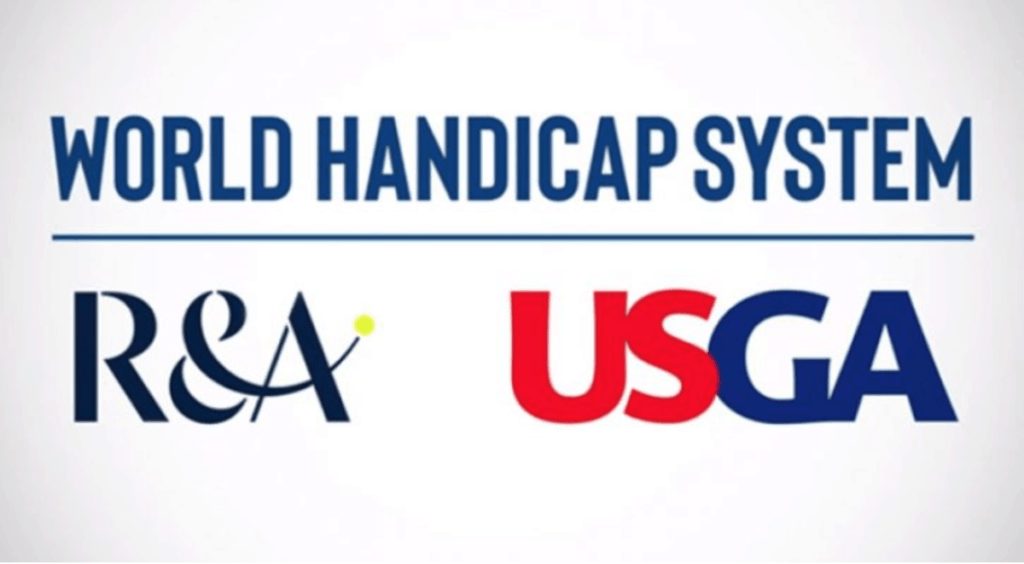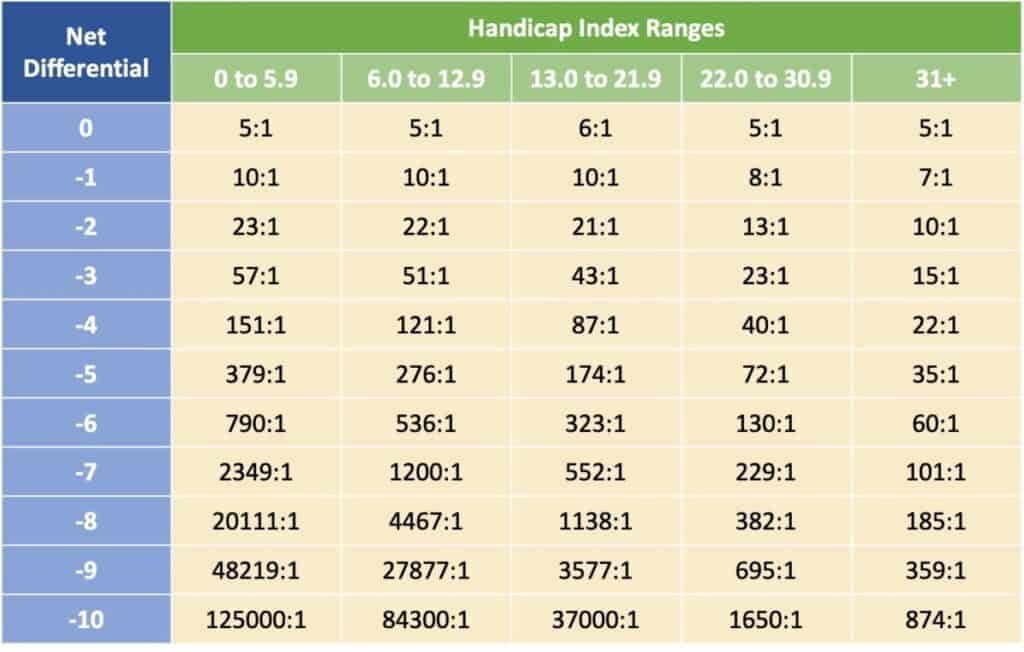How Often Should You Hit Your Golf Handicap? It’s Good News!

Your golf handicap is supposed to be based on a complex calculation of your scores over an extended period of time which shows to the golf playing world exactly how good you are.
So why does it feel sometimes like you could count on one hand the number of times you actually play to your handicap during the course of a season?
Statistics show that the odds of the average golfer posting a net score lower than their handicap by only one stroke is 10:1 but what do they tell us about how often you should actually be playing to your golf handicap?
Golfers should hit their handicap or better 25% of the time and will on average score 3 strokes higher than their handicap according to research by the USGA handicap research team. This percentage increases as players improve and in stableford (31%) and par/bogey (44%) events compared to strokeplay.
Handicaps are very important to golfers.
When people first meet each other and discover they both play golf the most common question that follows is about what their handicap is.
But while talking about your ‘handicap number’ is all very well the most important thing is whether you can back up the talk on the golf course and actually play to it.
That’s where things get a bit more interesting.
So in this article we’re not only going to look into the underlying calculations handicaps are based on but also the actual odds of you or any of your playing partners shooting better than your handicap by between 1 and 10 strokes!
How Often You Should Shoot Your Handicap is About Potential not Reality
A golfer’s handicap is the numerical value that measures a golfer’s ‘potential’, offering a scoring method that allows players of various skill levels to compete against each other.
The United States Golf Association (USGA) and The Royal & Ancient Golf Club of St Andrews (R&A) now set the standard for a golfer’s handicap as an average of their best eight rounds of golf out of the last 20.
That is why a player’s handicap is about ‘potential’.
It reflects their ‘best’ days on the course rather than for example simply an average of all his or her recent scores.
Their most recent 12 worst rounds, when things are not going so well or entirely going haywire, are entirely discarded from the handicap calculation.
But that also helps explain why the USGA’s Handicap Research Team says that not only will golfers only play to their handicap or better one out of every four rounds but they will also on average score 3 strokes higher than their course handicap.

That statistic however still does not tell the whole story when it comes to considering the question as to how often you should play to your handicap?
Golfers as we know are all different.
Better players are far more consistent than higher handicappers and the format of game golfers play will vary during the course of a regular season.
A lot of the time when you are playing a round which will count for your handicap it will be standard stroke play event but Stableford and par / bogey competitions will also likely be part of the schedule the average golfer competes in.
So golfers often wonder how often players of a similar standard to them really do shoot their handicap or how often they shoot their handicap when playing different types of competition.
To help answer this HowDidiDo, the largest golfing network anywhere in the world, has crunched the numbers of over 7.5 million scores posted in competitions and found the following.
In stroke play competitions 26% of golfers played to their handicap but in Stableford events that number rose to 31% and to just over 44% in par/bogey competitions.
So we can immediately see that the ‘base’ 25% number that the USGA Handicap Research Team analysed is affected by the format of competion they are playing.
When we look HowDidiDo’s data broken down by handicap groups in the table below we can also see that the overall 25% baseline again varies by the standard of golfer.
| HANDICAP | % OF TIMES SHOOT HANDICAP |
| 5 or less | 36% |
| 6 to 12 | 32% |
| 13 to 20 | 29% |
| 21 to 28 | 26% |
| 29 and above | 19% |
So better players will play to their handicap more often is the simple conclusion.
Which makes perfect sense and a bit obvious of course in a way but it also good to know in that it also clearly confirms the handicap system works.
Low handicapped players are more consistent and so inevitably make less mistakes and shoot better scores which will then be reflected in their lower handicap.
However there are also far fewer of them in number so the overall baseline is a lot less than their numbers above the 30% mark.
Saying that it still means than even the best amateur players are not shooting their handicap close to 2/3 of the time.
So the next time you are playing one in an event remember that your competitors’ handicaps only reflect their ‘potential’ and they are highly likely not to play to it on the day.
The only problem with that however is that the odds of you having an off day as well and not playing to your potential are not that good either!
[Editor’s note – In a ‘Par’ or ‘Bogey’ competition golfers basically play matchplay against the course. If a player makes a net birdie or better they win that hole and mark it with a +1. But if they make a net bogey or worse they lose the hole to the course and mark a -1. A hole is halved if the player scores a net par and the lost holes are subtracted from the won holes at the end of the round to give a final score.]
The World Handicap System has Changed the Calculation
In 2020, the USGA and the R&A, the organizations responsible for the rules of golf introduce the ‘World Handicap System‘ (WHS).
This new system brought together six different handicap systems from across the world (USA, UK, Europe, Australia, South Africa and Argentina) and now enables golfers of different standards from across the world to play and compete against other using comparable handicaps.
The WHS uses the best eight of your past 20 scores (the old USGA handicap system used the best 10 out of 20 scores) to calculate a golfer’s handicap index and it is most likely to feel like a bigger change for golfers outside the US.
For UK based players out the ‘buffer zone’ is no longer relevant and you will also no longer go up 0.1 automatically if you don’t play to your handicap.
Your handicap can now be adjusted every time you play under WHS as your latest round causes the oldest one in the last 20 to be discounted.
There are a couple of key things also for everyone to note about the new WHS system though.

Firstly although the formula that calculates your Handicap Index isn’t fundamentally changing the one that computes how many shots you will get from any set of tees is.
Previously your course handicap was worked out based on your handicap index in relation to ‘course rating’ – i.e. Course handicap was: Handicap Index multiplied by a course’s slope rating divided by 113 (or Course handicap = Handicap Index x slope rating / 113)
Now the new calculation for course handicap takes into account ‘the number of strokes you get in relation to par’.
In other words course handicap now equals your handicap index multiplied by the course slope rating divided by 113 PLUS the course rating less par (or Course handicap = Handicap Index x (Slope Rating/113) + (Course Rating – Par).
The principal reason for this change has been to accommodate players who play off different tees and help make it a fairer game.
A second key change has been in relation to the addition of a ‘playing conditions calculation’ or PCC.
The PCC now takes into account the average of all the scores posted that day to adjust how your score impacts your handicap index.
So now on competition days where it is pouring with rain or blowing a gale causing all the scores to be way higher than normal, the WHS computation will use the PCC to take this account, particularly if all the scores are high on a particular day.
Although obviously this is early days it is expected that amateur golfers in general are going to have lower handicaps under the WHS with fewer fluctuations because weather and par will also be considered.
In other words it looks like the good news about the WHS is it might mean you play to your handicap more often than you did before!
What is my Handicap under the new WHS based on my score?
The new World Handicap System (WHS) introduced in 2020 uses the best eight rounds of a golfer’s last 20 scores to calculate their current handicap.
But how do you get a handicap in the first place? What is your handicap if you shoot 100, 90, or 80?
According to the USGA, a golfer’s handicap ‘differential’ is the “the difference between a player’s gross adjusted score and the USGA course rating of the course on which the score was made, multiplied by 113, and then the total is divided by the USGA Slope Rating from the tees played rounded off to the one decimal place.”
In other words:
(Score – Course Rating) x 113) /Slope Rating
As an example, let’s say that a golfer plays the Pebble Beach Golf Course and shot a 100. The USGA gives Pebble Beach a course rating of 75 and a slope rating of 130. Following the formula above, calculating your handicap would look like this:
(100 – 75) x 113/130 = 21.7
But this is only one round.
A total of 54 holes, which can made up of any combination of 18-hole and 9-hole rounds of golf, must be played for a golfer to get an official handicap .
It’s also important to note that your ‘score’ will be ‘adjusted’ before it is put into the calculation. This means any holes where the net score is more than 2 over par will be ‘adjusted’ to the maximum of net 2 over par.
(Adjusted score – Course rating) * 113) / Slope rating
And for the initial handicap calculation the max net par is 3 over par.
What are the Odds Golfers Will Beat Their Handicap?
When it comes to having a handicap in golf what is really the point?
After all the majority of golfers don’t have an official handicap – of the 24.2 million golfers in the USA (i.e. adults who played at least one regulation round in the past year) less than 20% have an official handicap.
USGA studies however show golfers with handicaps make better connections inside the golf community and play more rounds.
And part of the reason for this is inevitably the competition that handicaps allow between friends and players of all standards.
There can be nothing quite like the thrill of beating your buddies or the best player in the club who you could not even contemplate playing without the benefit of strokes based on the difference between your two handicaps.
But if there’s one thing golfers are united in it is their dislike of the ‘miracle round’ in competition rounds by a (and I apologise now for mentioning the word!) ‘sandbagger’.
Play golf long enough and you’ll come up against golfers playing off a high handicap who magically seem to play the ‘best golf they’ve ever played’ on competition day to walk away with all the prizes.
In other words they look like they are way better than they claim they are and you are deeply suspicious that they have a false, or being more generous, a ‘misleading’ handicap index.
Thankfully, again due to the great work of the USGA Handicap Research team, we have the back up we need thanks to the ‘Exceptional tournament score probability table’.
This table highlights the odds of any golfer hitting their handicap or shooting up to 10 strokes better than it.

So the next time you are at an event and have your ‘sandbagging’ suspicions you can use this table to work out what the exact odds of that player shooting that round were.
For example the odds of a golfer with a course handicap of 14 beating their handicap by 8 strokes is 1,138 to one.
Looking at it another way, and assuming the average golfer plays 20 rounds a year, it would take them over 56 years of golf to do it once.
This is all not to say it’s not possible for players to have a great round and these should absolutely be celebrated.
It’s just a helpful guide to show you the likelihood of it happening often and if it does I would suggest that player’s handicap index needs looked at.
The good news with the WHS however is to safeguard against any dubious scoring practices by players it caps the maximum score on any hole to a new double bogey as a universal standard.
This works in the same way as the ‘Equitable Stroke Control’ did in the old USGA system which capped max scores based on handicap (e.g. 10-19 handicap could take no more than 7 on any hole, 20-29 could take not more a max 8 etc.) but by adopting net double bogey as a universal standard provides consistency throughout the world in its application.
So there should be no examples now of golfers having a deliberate bad hole to make sure their handicap stays high for future competitions!
What’s an Average, Good and Bad Handicap?
Golfers are typically pretty obsessed with how their handicap measures up against everyone else and so questions about what is a good or bad or average handicap are very common.
So we did some research to find out what the average handicap for golfers in different parts of the world is. Here is what we found out:
| AVERAGE HANDICAP | ||
| COUNTRY | MEN | WOMEN |
| USA | 14.4 | 26.4 |
| UK | 16 | 25 |
| England | 17.2 | 26.5 |
| Australia | 16.9 | 26.7 |
| Sources: USGA, R&A, England Golf, Golf Australia | ||
So if you have a 12 handicap as a male golfer for example the average handicap in different parts of the world would indicate that it is a good handicap as it is at least a couple of strokes better than the average handicap in the US, the UK and Australia.
A 12 handicap for a female golfer by comparison would be excellent given the much higher average handicap numbers.
Given also that it is estimated more than 80% of golfers don’t have a handicap the averages which are reported in different countries are very likely to be artificially low.
So however your handicap stacks up against the average, due to the fact that the majority of players who ‘play golf’ don’t have a handicap and therefore tend to shoot higher scores, it is likely that your handicap is better than it appears when compared to the rest.
The general similarity of the average handicap for both men and women in these countries also suggests that golfers across the world play on average to a very similar standard.
But these average comparisons were taken during a period before the World Handicap System (WHS) had taken effect and although they were similar, different handicap systems around the world operated according to their own guidelines.
With WHS now in force however, you will be able to compare your handicap with players from pretty much anywhere with the confidence that you will finally know how your handicap stacks up against the rest of the world!
More top articles related to this topic:
- Are You Average? A Complete Guide to Average Golf Handicaps
- 10 Ways to Lower Your Handicap Fast. No Swing Changes Needed!
- How Do You Make That Jump to a Single Figure Handicap?
- 5 Fun Buddy Golf Trip Games for a Wide Range of Handicaps
- Complete Guide to the Good, the Bad & the Ugly of Golf Scores
- 10 Best Golf Stats to Keep Track of. Start with ‘Major Mistaks’
- 5 Top Tips to Beat a Better Golfer
- 11 Fun Golf Games for Odd Numbers with Wide Range of Handicaps
RECENT ARTICLES
LEGAL INFORMATION
This site is owned and operated by Golfing Focus Limited, a private limited company whose registered office is in London, UK. Golfing Focus Limited is a participant in the Amazon Services LLC Associates Program, an affiliate advertising program designed to provide a means for sites to earn advertising fees (at no cost to you) by linking to Amazon.com. Golfing Focus Limited also participates in other affiliate programs with the eBay Partner Network, FlexOffers, CJ.com, Svorn and other sites and is compensated for referring traffic and business to these companies (again at no cost to you).
Our Socials






Leave a Reply